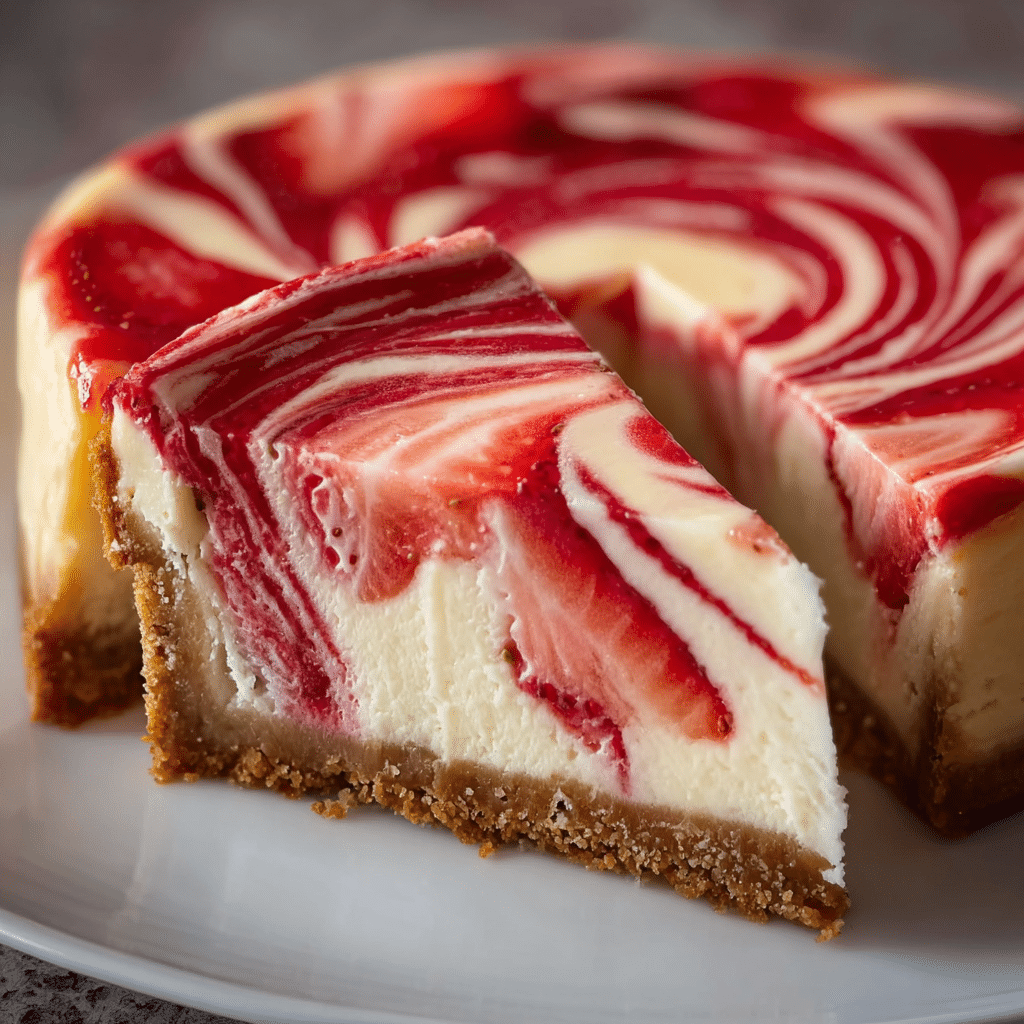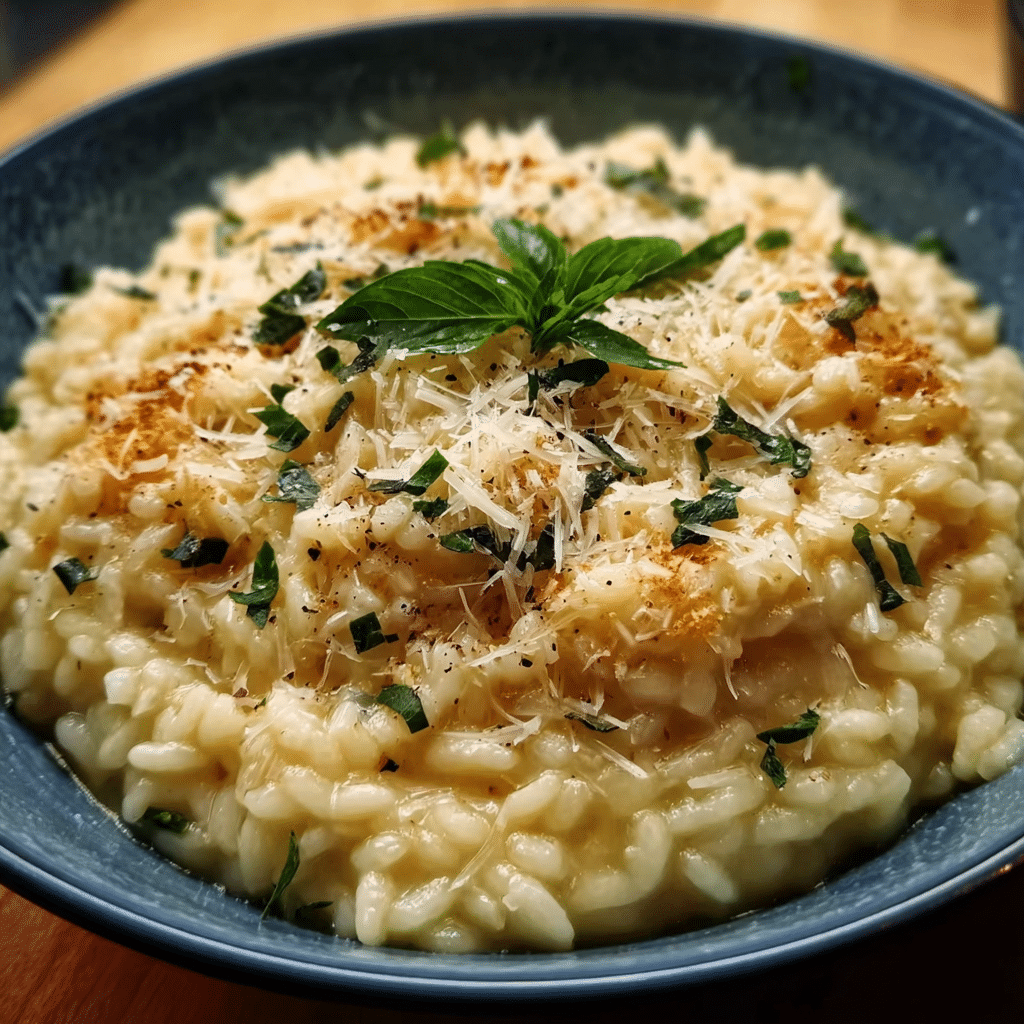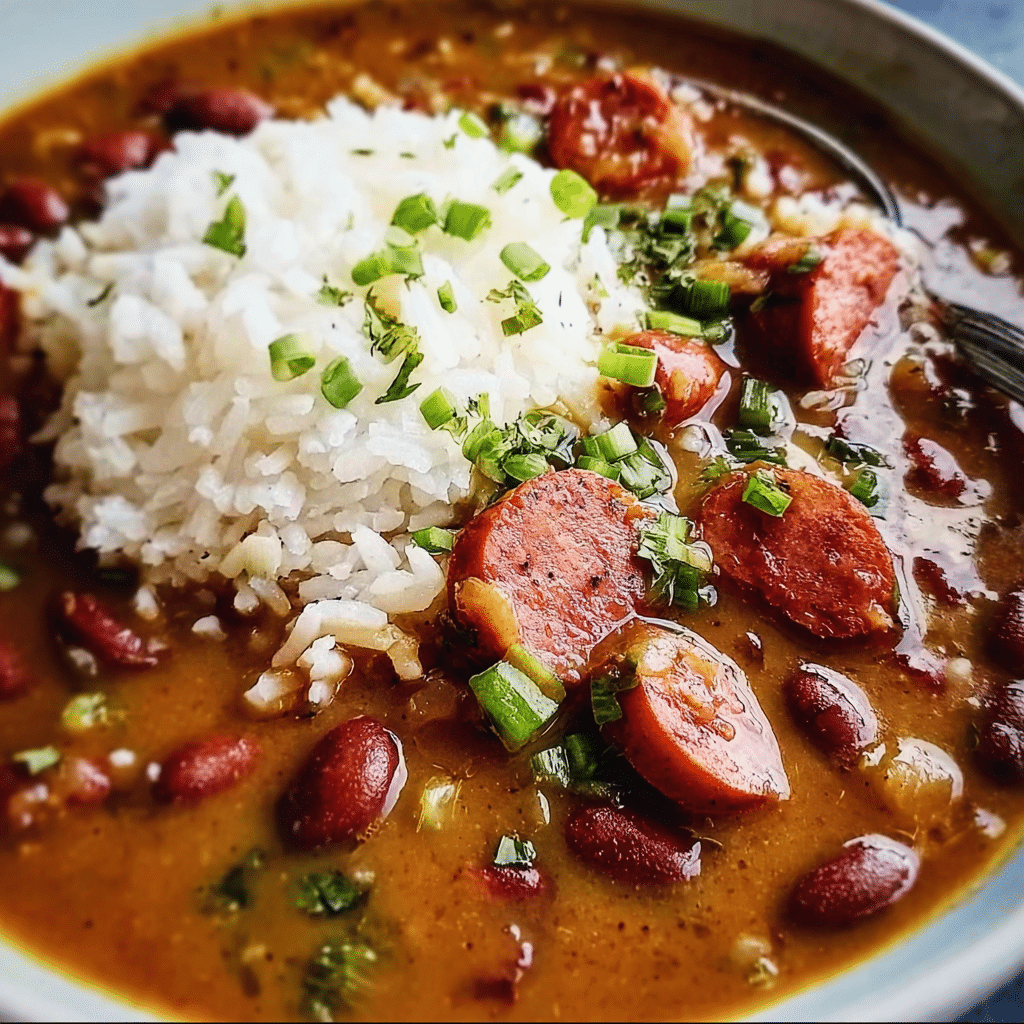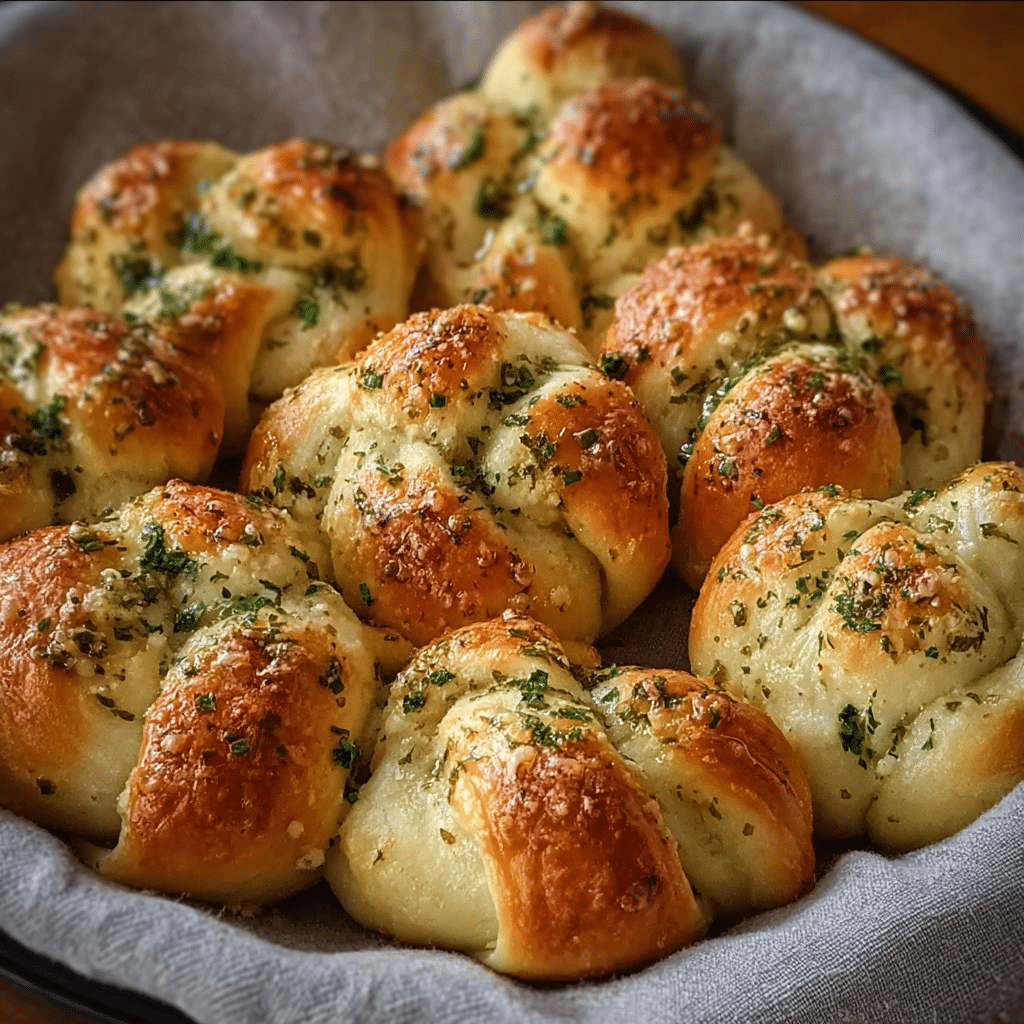Tri colored rotini is not just a pasta; it’s a canvas for culinary creativity, a vibrant blend of flavors and textures that can brighten any meal. I remember the first time I stumbled upon a colorful pasta salad at a family gathering. My aunt had prepared a dish featuring tri colored rotini, and it was an instant hit. The spirals of red, green, and golden pasta danced on the plate, making it impossible to resist. As I took my first bite, the combination of fresh cherry tomatoes, crisp veggies, and tangy dressing brought a burst of flavor that was as delightful as the colors promised. It was a moment that ignited my passion for cooking and experimenting with pasta, leading me to create my own version of this dish that has become a staple in my family’s meal rotation.

The Story Behind This Recipe
Growing up, I watched my grandmother whip up various pasta dishes, each with their own unique flair. However, tri colored rotini was a special treat that she reserved for summer gatherings. It reminded me of the lively picnics in our backyard, where laughter filled the air, and the sight of colorful dishes made everything feel festive. As I began to cook for my own family, I wanted to replicate that joy, and tri colored rotini became my go-to. It’s incredibly versatile, allowing me to customize it with whatever fresh ingredients are available. Whether it’s a simple weeknight dinner or a potluck dish, this pasta salad always brings smiles and satisfied bellies.
This dish is especially perfect for busy families looking for quick dinner solutions. With just a few ingredients and minimal preparation, you can create a colorful and nutritious meal in no time. The tri colored rotini cooks quickly and holds up well to dressings, making it an ideal choice for meal prep or last-minute dinners. I often find myself reaching for this recipe when I need something that balances nutrition with flavor, ensuring my family enjoys their meals while I juggle the demands of daily life.
Why You’ll Love This Dish
One of the reasons this tri colored rotini pasta salad stands out is its seasonal relevance. It’s a dish that shines in the summer months when fresh cherry tomatoes are at their peak. The juicy sweetness of the tomatoes complements the earthy flavors of the rotini and the crunch of seasonal vegetables, creating a refreshing experience that feels like a celebration of summer. However, this dish can easily transition into the cooler months by incorporating roasted vegetables or hearty additions like grilled chicken or chickpeas.
Emotionally, this dish holds a special place in my heart. It embodies the essence of family gatherings, laughter, and love. Every time I prepare it, I am reminded of those sun-soaked afternoons spent with my loved ones, sharing stories and creating memories. My children have also come to associate tri colored rotini with fun family meals, making it a dish that connects us across generations.
As you read through this guide, you can expect to learn not just how to prepare a delicious tri colored rotini pasta salad but also tips on personalizing it to suit your taste. From dressing options to ingredient variations, you’ll discover how to make this dish your own while enjoying the rich history and cultural significance behind it. Let’s embark on this flavorful journey together and ensure your next meal is as vibrant and enjoyable as the beautiful spirals of tri colored rotini!
The Rich History and Cultural Significance of tri colored rotini
The rich history and cultural significance of tri colored rotini can be traced back to Italy, where pasta has been a staple for centuries. The term “rotini” itself comes from the Italian word for “twist,” aptly describing the spiral shape that is perfect for holding sauces and ingredients. While traditional pasta is typically made from durum wheat, the tri colored variety is created by adding natural ingredients like spinach and beetroot to the dough, giving it its signature colors. This addition not only enhances the visual appeal but also provides a boost of nutrients, making it a healthier choice for pasta lovers.
Origins and History
The origins of tri colored rotini are deeply rooted in Italian culinary traditions. Pasta has been a part of Italian culture since at least the 12th century, with various forms appearing in regional cuisines across the country. The introduction of colored pasta, particularly the tri colored variant, adds a modern twist to these age-old traditions. It emerged in the late 20th century when chefs and home cooks began experimenting with different types of pasta in an effort to make meals more visually appealing and nutritious.
One of the fascinating aspects of tri colored rotini is its adaptability. In Italy, pasta dishes vary significantly by region, with each area boasting its own unique styles and flavors. For example, in the south, you might find pasta served with spicy tomato sauces, while in the north, creamy pesto or cheese-based sauces take center stage. The versatility of tri colored rotini means it can seamlessly integrate into various regional Italian dishes, allowing for endless possibilities in the kitchen.
Cultural Significance
In Italian culture, pasta is more than just food; it is a symbol of togetherness and family. Meals are often communal, with families gathering to enjoy a hearty plate of pasta, share stories, and strengthen bonds. Tri colored rotini has become a popular choice for celebrations, potlucks, and family gatherings, cherished for its festive appearance and ability to please a crowd. Whether it’s a summer barbecue or a holiday feast, this pasta salad often finds its way to the table, embodying the spirit of celebration and unity.
Famous chefs and restaurants have embraced tri colored rotini, showcasing it in innovative dishes that highlight its unique qualities. Chefs often use it as a base for gourmet salads or pair it with upscale ingredients to elevate the classic pasta dish. This blend of rustic roots and modern culinary creativity has helped solidify tri colored rotini’s place in both home kitchens and fine dining establishments.
Print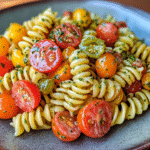
Tri Colored Rotini Recipe – Complete Guide
Ingredients
- 12 oz box tri color rotini pasta
- 1/2 cup Italian salad dressing
- 3 stalks of celery finely chopped
- 1 pint cherry or grape tomatoes halved
- 1/2 cup sliced black olives
- 1 tablespoon dried basil
- 1 tablespoon dried oregano
- 1/2 cup shredded mozzarella
Instructions
- Prepare your pasta as directed on box. Drain and place pasta in a big serving bowl.
- Add salad dressing, celery, tomatoes, olives, basil and oregano. Stir to fully combine. Add mozzarella cheese on top and mix again.
-
Cover bowl with lid or plastic wrap and place in refrigerator to chill (at least an hour, can be overnight).
-
Remove from refrigerator and stir to freshen up. If salad looks a little dry (especially if you let it sit overnight), add a tablespoon (or 2) of salad dressing and stir. Serve and enjoy!
Nutritional Benefits
From a nutritional standpoint, tri colored rotini offers several benefits that make it a smart choice for families. The addition of spinach and beetroot not only enhances the visual appeal but also boosts the nutritional profile. Spinach is rich in iron, vitamins A and K, while beetroot adds antioxidants and essential nutrients, making this pasta a more wholesome option compared to traditional varieties. The combination of whole grains and these vibrant ingredients provides a satisfying meal that fuels the body without compromising on flavor.
In conclusion, tri colored rotini is more than just a pasta; it is a dish steeped in history, culture, and nutritious goodness. From its origins in Italy to its current status as a beloved dish for families around the world, it continues to evolve while retaining its core essence. As you explore the world of tri colored rotini, you’ll not only discover a delightful recipe but also the rich tapestry of stories and traditions that come with it. So gather your ingredients, embrace your creativity, and let this vibrant pasta transform your meals!
Essential Ingredients for Perfect tri colored rotini
When it comes to creating a vibrant and delicious tri colored rotini pasta salad, the ingredients you choose play a pivotal role in the overall flavor, texture, and visual appeal of the dish. In this section, we will explore each essential ingredient needed for the perfect tri colored rotini salad, diving deep into their importance, quality indicators, and even some clever tips for sourcing and storage.
Essential Ingredients
- Tri Colored Rotini Pasta – 8 ounces
- Cherry Tomatoes – 1 pint, halved
- Cucumber – 1 medium, diced
- Red Bell Pepper – 1, diced
- Red Onion – ¼ cup, finely diced
- Feta Cheese – ½ cup, crumbled
- Fresh Basil – ¼ cup, chopped
- Olive Oil – ¼ cup
- Red Wine Vinegar – 2 tablespoons
- Garlic – 2 cloves, minced
- Salt and Pepper – to taste
The star of our salad is, of course, the tri colored rotini. This pasta not only adds a delightful twist in flavor and texture but also brings an attractive splash of color to your dish. The tri-colored aspect usually comes from the addition of spinach and beet puree, which adds a bit of earthiness that complements the fresh ingredients beautifully.
Next, we have our cherry tomatoes. These juicy gems are bursting with flavor and provide a refreshing contrast to the richness of the feta cheese. When selecting cherry tomatoes, look for ones that are firm and bright in color, as these indicate ripeness and sweetness. In the summer months, you might even consider visiting a local farmer’s market to pick up some freshly harvested ones, which will elevate your salad even further.
Cucumbers add a refreshing crunch to your tri colored rotini pasta salad. Opt for English cucumbers when possible, as they have fewer seeds and a thinner skin, making them perfect for salads. A fresh cucumber should be firm and dark green. You can also peel it if you prefer a milder taste.
Red bell peppers not only contribute color but also a sweet crunch. Choose ones that are glossy and feel heavy for their size. Additionally, red onion adds a sharp bite that balances the sweetness of the tomatoes and peppers. You can soak the diced onions in cold water for a few minutes to mellow their flavor if desired.
Feta cheese is a classic addition that introduces a tangy creaminess to the salad. Look for high-quality feta, preferably made from sheep’s milk, which has a richer flavor than cow’s milk feta. You can crumble it yourself for the freshest taste. Fresh herbs like basil not only enhance the flavor but also add an aromatic freshness that ties all the ingredients together beautifully.
As for the dressing, a simple combination of olive oil, red wine vinegar, and garlic creates a flavorful base. When choosing olive oil, extra virgin is the way to go for its robust flavor. Look for cold-pressed, as it retains more nutrients and flavor. Red wine vinegar adds a tangy acidity, balancing out the richness of the oil and cheese.
Shopping Tips
When shopping for ingredients, I recommend visiting your local farmer’s market or grocery store that prioritizes fresh produce. This is especially important for items like tomatoes, cucumbers, and herbs, which are best when in season. For the tri colored rotini, many grocery stores now offer various pasta options, including gluten-free alternatives, which are worth exploring if you have dietary restrictions.
If you can, try sourcing organic ingredients. Organic vegetables often taste better, as they are grown without synthetic fertilizers and pesticides. This is particularly relevant for your salad, as fresh, untainted flavors will shine through in every bite.
To keep costs down, consider buying in bulk when possible, especially for items like olive oil and vinegar, which can be used in various recipes. You can also make your own dressing at home, which is not only cost-effective but allows you to customize flavors to your liking.
Substitutions and Alternatives
For those with dietary restrictions, there are plenty of substitutions you can make without sacrificing flavor. If you need a gluten-free version, look for gluten-free tri colored rotini made from rice or quinoa. For a vegan option, simply omit the feta cheese or substitute it with a plant-based cheese alternative.
If you’re watching your sodium intake, consider using a low-sodium feta or reducing the amount of salt in the dressing. You can also add additional veggies like carrots or zucchini for extra crunch and nutrition, or replace the red onion with green onions for a milder flavor.
Finally, any leftovers can be stored in an airtight container in the refrigerator for about 3-5 days. Keep in mind that the pasta may absorb the dressing over time, so you might want to add a bit more dressing when you serve it again.
Detailed Step-by-Step tri colored rotini Cooking Instructions
Now that we’ve gathered all of our ingredients, let’s dive into the cooking instructions for our delightful tri colored rotini pasta salad. This step-by-step guide will ensure that your dish comes out perfectly every time, and trust me, the process is just as enjoyable as the final product!
Preparation Steps
- Gather your ingredients: Before you begin, make sure all your ingredients are at hand. This makes the cooking process smoother and more enjoyable. I always find it helpful to have a bowl or container for each ingredient, ready to go.
- Boil the water: Fill a large pot with water and bring it to a rolling boil. For the best flavor, add a generous pinch of salt to the water; this helps season the pasta. I usually wait until the water is at a full boil before adding the pasta, which ensures the pasta cooks evenly.
- Cook the tri colored rotini: Once the water is boiling, add the 8 ounces of tri colored rotini. Stir it gently for the first couple of minutes to prevent sticking. Cook according to package instructions, typically 8-10 minutes, until al dente. Remember, you want a slight bite to the pasta, as it will continue to cook slightly when mixed with the other ingredients.
- Prepare the vegetables: While the pasta is cooking, wash and chop your cherry tomatoes, cucumber, red bell pepper, and red onion. I find that cutting all the vegetables into similar sizes enhances the overall aesthetic and makes for a better eating experience.
- Drain and cool: Once the pasta is cooked, drain it in a colander and rinse it under cool water. This step stops the cooking process and helps to firm up the pasta. Let it drain thoroughly while you prepare your dressing.
Cooking Process
- Make the dressing: In a small bowl, whisk together ¼ cup of olive oil, 2 tablespoons of red wine vinegar, and minced garlic. I like to add a pinch of salt and pepper to taste at this stage. You can always adjust the seasoning later, but starting with a little helps to build flavor.
- Combine the ingredients: In a large mixing bowl, combine the drained tri colored rotini, chopped vegetables, and feta cheese. Pour the dressing over the top and gently toss everything together until well combined. I usually use two large spoons, making sure to lift from the bottom to avoid breaking the pasta.
- Add fresh herbs: Right before serving, stir in the chopped basil. This adds a fresh, aromatic note to the salad and brings all the flavors together beautifully. If you can, use fresh basil rather than dried; the difference is truly remarkable.
- Taste and adjust: At this point, take a moment to taste your salad. You may want to add a bit more salt, pepper, or even a splash more vinegar depending on your preference. It’s all about balance!
Final Assembly
- Chill (optional): If you have the time, let the salad chill in the refrigerator for about 30 minutes before serving. This allows the flavors to meld together, resulting in a more cohesive dish.
- Serve: To serve, scoop generous portions onto plates or into bowls. This salad can be enjoyed warm, at room temperature, or cold, making it a versatile option for any occasion.
- Garnish: For a finishing touch, consider a sprinkle of extra feta, a drizzle of olive oil, or even a few whole leaves of basil on top. Presentation matters, and a little garnish can elevate your dish visually!
Throughout this cooking process, be mindful of timing. If you multitask efficiently—chopping while the pasta cooks—you can have this delicious tri colored rotini pasta salad ready in about 30 minutes. The key is to keep an eye on your pasta, as overcooked pasta can ruin the texture. Enjoy the process, and remember that cooking is all about creativity and personal touch. Your tri colored rotini pasta salad will not only be a feast for the eyes but also a delicious addition to any meal!
Professional Tips and Techniques for tri colored rotini
When it comes to creating a vibrant and delicious dish, nothing captures the eye and palate quite like a well-prepared tri colored rotini pasta salad. This delightful dish, featuring lively hues of green, white, and red pasta, is not only a feast for the eyes but also a canvas for flavor and creativity. To help you elevate your tri colored rotini experience, I’ve gathered some professional tips and techniques that will turn your salad into a showstopper.
Professional Techniques
Cooking is as much about technique as it is about ingredients. To prepare the perfect tri colored rotini, start by selecting high-quality pasta. Look for brands that use durum wheat semolina, as it provides a firm texture that holds up well with dressings and other ingredients. When cooking your pasta, always remember to salt your water generously. This step not only enhances the flavor of the pasta but also helps to prevent it from becoming mushy.

When boiling tri colored rotini, follow the package instructions for al dente cooking. This usually means cooking the pasta for about 8-10 minutes. To test for doneness, taste a piece! It should be tender but still have a slight chew. Once cooked, immediately drain the pasta and rinse it under cold water to halt the cooking process, prevent sticking, and maintain its vibrant colors.
Incorporating fresh herbs can elevate the flavor of your tri colored rotini pasta salad significantly. Consider using basil, parsley, or even mint for a refreshing twist. A simple trick is to chop the herbs finely and mix them with olive oil before adding them to the salad. This allows the oils to extract the flavors from the herbs, creating a fragrant dressing that permeates the entire dish.
Troubleshooting Guide
Even the best cooks encounter issues from time to time. One common problem with pasta salads is that they can become dry or clump together. To combat this, be sure to coat your tri colored rotini with a light drizzle of olive oil right after draining. This prevents the pasta from sticking and makes it easier to mix in your other ingredients later.
If your pasta salad ends up being too salty, try adding a few extra vegetables or a splash of vinegar to balance the flavors. For those who find their dressing too thin, you can thicken it by mixing in a bit of Greek yogurt or sour cream for creaminess. Remember, adjusting the components of your dish is all part of the cooking journey!
Presentation Tips
When it comes to serving your tri colored rotini pasta salad, presentation can make all the difference. Start with a large, colorful serving bowl to showcase the pasta’s vibrant hues. You can layer the salad by placing a base of greens, then adding the tri colored rotini on top, followed by your choice of vegetables and proteins. Garnish with a sprinkle of freshly grated Parmesan cheese or toasted pine nuts for added texture and visual appeal.
To create an impressive display, consider using edible flowers or herbs as a garnish. This not only enhances the presentation but also adds an aromatic element to the dish. For a more formal setting, try serving individual portions in mason jars for a charming picnic-style experience, allowing guests to enjoy their salad on the go.
Pairing your tri colored rotini with the right beverages can enhance the overall meal experience. A crisp white wine, such as a Sauvignon Blanc or a Pinot Grigio, complements the flavors of the salad beautifully. If you prefer non-alcoholic options, consider serving sparkling water infused with fresh lemon or cucumber slices to cleanse the palate between bites.
Make-Ahead and Meal Prep Strategies
One of the best aspects of tri colored rotini pasta salad is its versatility and make-ahead potential. You can prepare the salad a day in advance, allowing the flavors to meld beautifully. Just be sure to store it in an airtight container in the refrigerator. If you’re meal prepping for the week, consider keeping the dressing separate until you’re ready to serve. This will help maintain the salad’s freshness and prevent sogginess.
Scaling your recipe up or down is also a breeze. If you’re hosting a large gathering, simply double or triple the ingredients. Conversely, if you’re cooking for one or two, you can easily halve the recipe. The beauty of tri colored rotini is that it can easily adapt to any occasion, whether it be a casual family dinner or an elegant potluck.
Creative Variations and Adaptations of tri colored rotini
While the classic tri colored rotini pasta salad is a delightful dish on its own, the possibilities for creativity and adaptation are endless. Whether you want to incorporate seasonal ingredients, cater to dietary restrictions, or simply experiment with new flavors, there’s a variation for everyone. Let’s dive into some exciting adaptations that will keep your tri colored rotini fresh and fun!
Seasonal Variations
One of the best ways to enjoy your tri colored rotini pasta salad is by incorporating seasonal ingredients. In the summer, think about adding juicy cherry tomatoes, crisp cucumbers, and sweet corn for a refreshing twist. These ingredients not only enhance the flavor but also bring a burst of color to your dish.
During the fall, consider roasted butternut squash, sautéed kale, and cranberries for a warm, hearty salad. The sweetness of the squash and tartness of cranberries will beautifully complement the tri colored rotini, creating a seasonal masterpiece. You can even toss in some toasted walnuts for added crunch and nutrition.
Winter months call for hearty ingredients such as roasted Brussels sprouts or hearty greens like arugula and spinach. The nutty flavors of these vegetables pair well with the tri colored rotini and can be drizzled with a balsamic glaze for an extra layer of flavor. You can also experiment with different cheeses, such as feta or goat cheese, to add richness to your salad.
Dietary Adaptations
In today’s world, dietary restrictions are more common than ever. Luckily, tri colored rotini is quite accommodating. For those following a gluten-free diet, substitute traditional pasta with gluten-free rotini made from rice or quinoa. These alternatives maintain the shape and texture of traditional pasta, ensuring your salad remains delicious.
If you’re looking for a vegan option, simply replace any cheese or creamy dressings with plant-based alternatives. A cashew cream dressing or a simple vinaigrette made from olive oil, lemon juice, and herbs can provide an excellent flavor without dairy. Additionally, you can amp up the protein content by adding chickpeas or lentils, making it a fulfilling main dish.
Creative Twists
To truly put a unique spin on your tri colored rotini pasta salad, consider international fusion variations. For a Mediterranean flair, incorporate ingredients like olives, artichokes, and sun-dried tomatoes, tossing them with a lemon-oregano dressing. This combination creates a delightful taste reminiscent of a sun-soaked seaside vacation.
If you want to venture into Asian flavors, why not try adding edamame, shredded carrots, and sesame seeds? Toss the salad with a ginger-soy dressing for a refreshing and zesty meal. This variation showcases the adaptability of tri colored rotini, proving it can take on flavors from various cuisines.
Don’t forget about spice level adjustments! Depending on your taste preferences, you can add a pinch of crushed red pepper flakes or a drizzle of sriracha for a kick. Alternatively, if you want to keep things mild, add in some creamy avocado for richness and to balance any heat.
Lastly, if you find yourself with leftovers, don’t let them go to waste! Transform your tri colored rotini salad into a delicious stir-fry or bake it into a pasta casserole. Simply toss the leftovers in a skillet with some olive oil and additional vegetables, or layer it in a baking dish with cheese and bake until bubbly. The options are endless, and your creativity is the only limitation!
Storage, Reheating, and Meal Prep for tri colored rotini
When it comes to enjoying a colorful and delightful dish like tri colored rotini pasta salad with cherry tomatoes, knowing how to store, reheat, and meal prep for this vibrant creation can enhance your culinary experience. Whether you’re making it for a picnic, a family gathering, or just for yourself, having a solid understanding of food storage practices can ensure that your tri colored rotini remains fresh, flavorful, and safe to eat.
Short-term Storage
After preparing your tri colored rotini pasta salad, the first thing to consider is how to store it if you’re not consuming it right away. The best practice is to allow the salad to cool down to room temperature if it’s still warm. This prevents condensation from forming inside the storage container, which can make the pasta soggy. Once cooled, transfer your pasta salad into an airtight container. Glass containers are excellent for this, as they don’t impart any flavors and allow you to see the vibrant colors of your tri colored rotini.
In the refrigerator, your tri colored rotini pasta salad is best consumed within 3 to 5 days. However, if you find yourself with leftovers, you can extend its life slightly by ensuring that the dressing is stored separately. When you’re ready to eat, just toss the salad with the dressing to rejuvenate the flavors. If you notice any signs of spoilage, such as an off smell or visible mold, it’s best to err on the side of caution and discard the salad.
Freezing and Long-term Storage
Freezing tri colored rotini pasta salad is not typically recommended due to the texture changes that can occur with the ingredients, especially the fresh vegetables like cherry tomatoes. However, if you’re determined to store it long-term, consider a few guidelines. First, cook the pasta just until al dente, as it will continue to soften when reheated. After cooling, place the salad in a freezer-safe container, but avoid adding any dressing at this stage. Instead, you can freeze the pasta and vegetables separately from the dressing, which can be added once you’ve defrosted everything.
To freeze, make sure to use containers that are specifically designed for freezing, as they can withstand lower temperatures without cracking. Label your containers with the date and contents, and consume within 2 to 3 months for the best flavor and texture. When ready to use, thaw your tri colored rotini salad overnight in the fridge, and then mix in the dressing just before serving. Remember, frozen pasta salad may not have the same crispness as freshly made, but it can still be a convenient meal option.
Reheating Best Practices
Reheating tri colored rotini pasta salad requires a gentle touch to maintain its quality. If you’ve stored your salad in the refrigerator, simply remove the desired portion and give it some time to come to room temperature. For those who prefer a warm pasta salad, you can gently reheat it in a pan over low heat. Add a splash of olive oil or a bit of dressing to prevent it from sticking and to enhance the flavors.
If reheating from frozen, it’s crucial to thaw it in the refrigerator overnight before reheating. This ensures even heating and helps to preserve the texture of the pasta. You can also use a microwave, but do so in short intervals, stirring frequently to avoid uneven heating. The key is to heat just until warmed through—overheating can lead to mushy pasta and wilted vegetables.

Meal prepping tri colored rotini salad can be a lifesaver during busy weeks. Prepare a large batch of the pasta salad at the beginning of the week, and divide it into individual portions. This way, you can grab a container for lunch or a quick dinner without the hassle of cooking each time. Use portion-sized containers that are easy to transport and store easily in the fridge. Also, consider prepping the ingredients ahead of time; you can cook the pasta and chop the veggies, storing them separately, and then combine them on the day you’re ready to enjoy the salad.
Food safety is paramount, especially when dealing with pasta salads that contain fresh ingredients. Always wash your hands before preparing food and ensure that your workspace and utensils are clean. When serving, avoid letting the salad sit out for more than two hours at room temperature to prevent bacterial growth. If you’re at a gathering, consider placing the salad over ice to keep it cool. Understanding the shelf life expectations—3 to 5 days in the fridge and 2 to 3 months in the freezer—will help you enjoy your tri colored rotini pasta salad at its best.
In conclusion, mastering the storage, reheating, and meal prep for your tri colored rotini pasta salad can transform it from a one-time dish to a staple in your meal rotation. With a little knowledge and care, you can enjoy this delightful pasta salad throughout the week, making every meal a colorful celebration of flavor and nutrition.
Nutritional Benefits and Health Information
When it comes to tri colored rotini pasta salad with cherry tomatoes, the culinary experience is not just about the taste and presentation; it’s also about the nutritional benefits that come from the ingredients. Understanding the health aspects of your meal can empower you to make informed choices in your diet. Let’s delve into the nutritional profile, health benefits, and dietary considerations of this delicious dish.
Nutritional Profile
At the heart of the tri colored rotini pasta salad is, of course, the tri colored rotini itself. This pasta, often made from durum wheat, is enriched with vegetables that provide the vibrant colors—typically spinach for green, beet for red, and tomato for orange. A standard serving of cooked tri colored rotini (about 1 cup) typically contains around 200 calories, with approximately 7 grams of protein, 1 gram of fat, and 42 grams of carbohydrates. This makes it a fantastic base for a balanced meal.
Adding cherry tomatoes not only brings a burst of flavor but also boosts the nutritional value. A cup of cherry tomatoes contains roughly 30 calories and is packed with vitamins A, C, and K. They’re also a good source of antioxidants, which help combat free radicals in the body. Other common ingredients in the salad, such as cucumbers, bell peppers, and fresh herbs, further enhance the nutrient profile, contributing vitamins, minerals, and fiber.
Health Benefits
The combination of tri colored rotini and fresh vegetables creates a dish rich in health benefits. The fiber content from the pasta and vegetables promotes digestive health, aiding in regularity and potentially lowering the risk of certain chronic diseases. The vitamins and antioxidants found in cherry tomatoes and other veggies support immune function and may reduce inflammation in the body.
Moreover, the colorful nature of this salad isn’t just pleasing to the eyes; it signifies a variety of nutrients. Eating a rainbow of fruits and vegetables can help ensure that you receive a broad spectrum of vitamins and minerals. The presence of healthy fats, especially if you add a dressing made with olive oil, helps with the absorption of fat-soluble vitamins A, D, E, and K.
Dietary Considerations
When preparing tri colored rotini pasta salad, it’s essential to consider dietary restrictions and allergens. This dish is naturally vegetarian, making it a suitable choice for those following a plant-based diet. However, for gluten-sensitive individuals, traditional pasta may not be suitable. Fortunately, there are gluten-free alternatives available, such as pasta made from rice or lentils, which can be used to make a gluten-free version of this vibrant salad.
For those watching their caloric intake or following specific diet plans like low-carb or keto diets, modifications can be made. Consider using spiralized vegetables, such as zucchini or carrots, as a substitute for some or all of the pasta. This will not only lower the carbohydrate count but also add an extra crunch to your salad.
When it comes to calorie content, a well-prepared tri colored rotini pasta salad can fit nicely into most meal plans. The key is to be mindful of portion sizes and the ingredients you’re using. Dressing can significantly impact the total calorie count, so opting for homemade dressings allows you to control the ingredients and avoid added sugars and preservatives.
In comparison to other pasta salads, the tri colored rotini pasta salad stands out due to its visual appeal and the health benefits provided by its colorful ingredients. Many traditional pasta salads lean heavily on creamy dressings and processed ingredients, which can add unnecessary calories and fats. By crafting a fresh version with vibrant vegetables and a light vinaigrette, you can create a dish that is both satisfying and nutritious.
In summary, the nutritional benefits of tri colored rotini pasta salad with cherry tomatoes extend beyond mere sustenance; it’s a celebration of healthful eating. By understanding the nutritional profile, health benefits, and dietary considerations, you can enjoy this dish fully, knowing it contributes positively to your overall wellness. Whether you’re serving it at a family gathering or enjoying it solo, this salad is a delightful way to nourish your body while tantalizing your taste buds.
Frequently Asked Questions About Tri Colored Rotini
Tri color pasta salad with Italian dressing
To make a delicious tri-color pasta salad with Italian dressing, start by cooking your tri-color rotini pasta according to the package instructions, ensuring it is al dente. Once cooked, drain and rinse under cold water to stop the cooking process and cool the pasta down. In a large bowl, combine the cooled pasta with diced vegetables such as bell peppers, cherry tomatoes, and red onions for added color and crunch. Pour in your favorite Italian dressing, mixing well to ensure all ingredients are evenly coated, and let the salad chill in the refrigerator for at least 30 minutes before serving. For extra flavor, consider adding olives, mozzarella balls, or fresh herbs like basil or parsley.
Tri Color pasta salad with Olive Garden dressing
For a tasty tri-color pasta salad using Olive Garden dressing, start by cooking your tri-color rotini pasta until al dente, then drain and rinse it under cold water. In a large mixing bowl, combine the cooled pasta with a variety of chopped vegetables like cucumbers, bell peppers, and black olives to add texture and flavor. Drizzle the Olive Garden dressing generously over the salad, tossing everything together until well combined. For added protein, consider incorporating grilled chicken or chickpeas, and let the salad sit in the fridge for at least an hour to allow the flavors to meld. This dish is perfect for potlucks or as a refreshing side dish during summer barbecues.
4 ingredient pasta salad
Creating a simple 4-ingredient pasta salad is easy and quick! Start by cooking tri-color rotini pasta according to the package directions, then drain and cool. The four main ingredients you can use are the pasta, Italian dressing, cherry tomatoes, and mozzarella balls. Combine these ingredients in a bowl, tossing them together until the pasta is well coated with dressing. If you want to enhance the flavor, you can add fresh basil or a sprinkle of Italian seasoning. This minimalist approach makes for a delicious and easy side dish that can be ready in just 15 minutes!
Pasta salad recipe
A versatile pasta salad recipe typically starts with cooked tri-color rotini pasta as the base. After cooking the pasta until al dente, rinse it under cold water to cool it down quickly. From there, you can get creative with your ingredients; consider adding diced cucumbers, bell peppers, olives, and diced red onions for color and crunch. For flavor, choose a dressing that suits your taste, such as ranch, balsamic vinaigrette, or a homemade Italian dressing, and don’t forget to mix in some herbs like parsley or oregano. Allow the salad to chill in the refrigerator for at least 30 minutes before serving to let the flavors blend beautifully.
Conclusion: Mastering the Perfect tri colored rotini
Creating the perfect tri colored rotini is more than just following a recipe—it’s about understanding the techniques, ingredients, and cultural significance behind this beloved dish. Throughout this comprehensive guide, we’ve explored everything from the historical origins to modern variations, ensuring you have all the knowledge needed to make this recipe your own.

